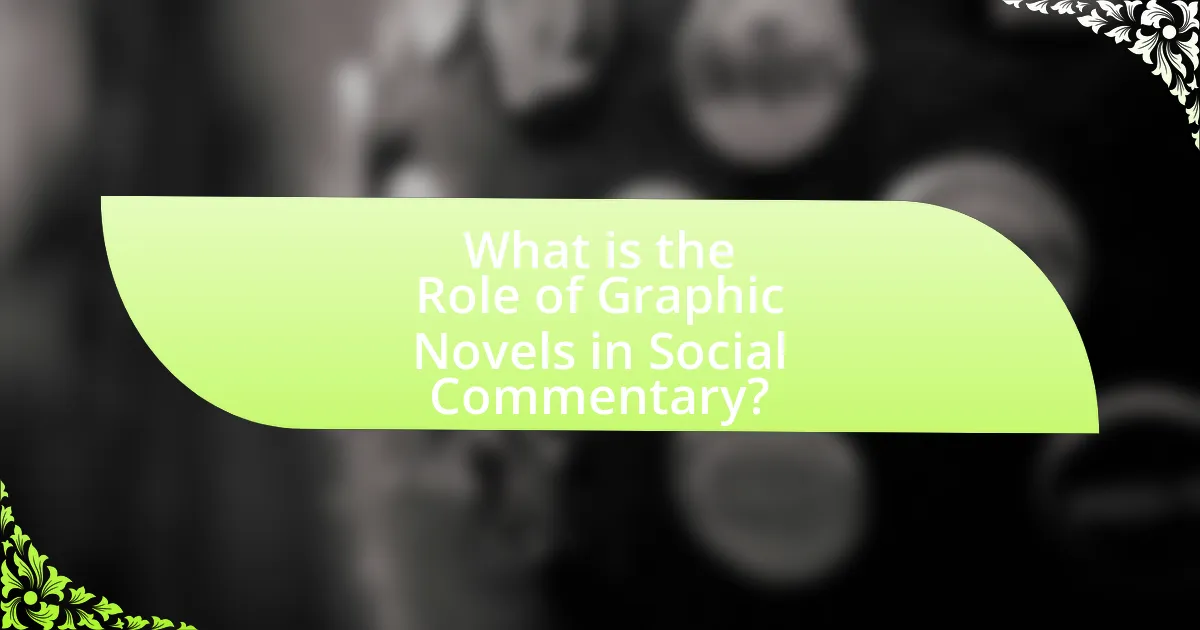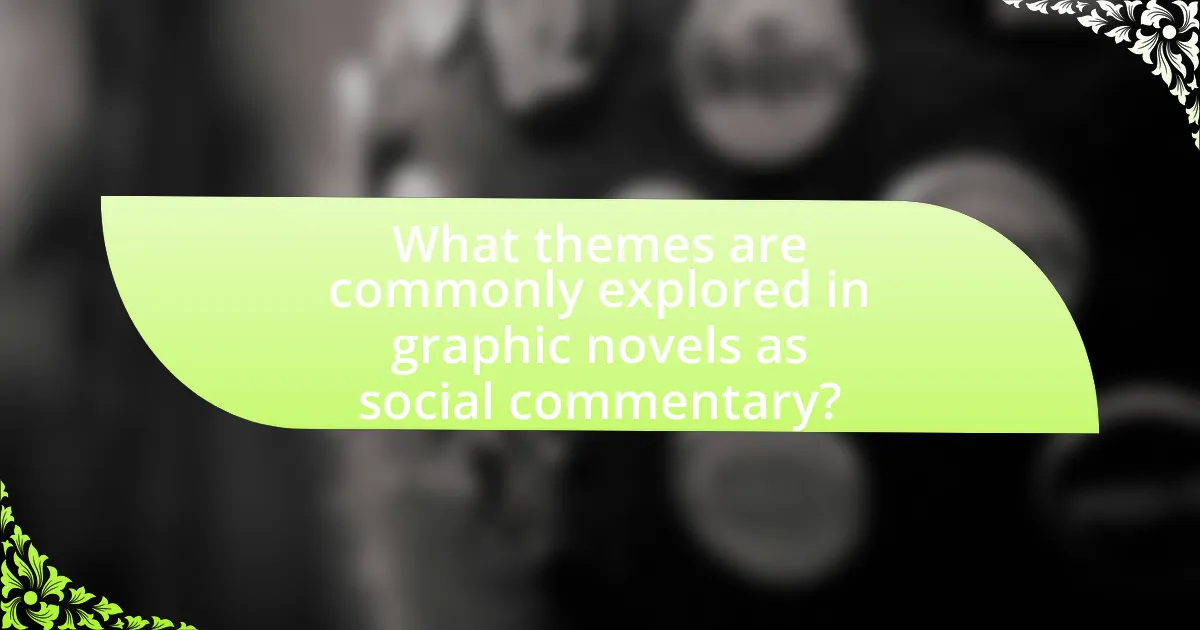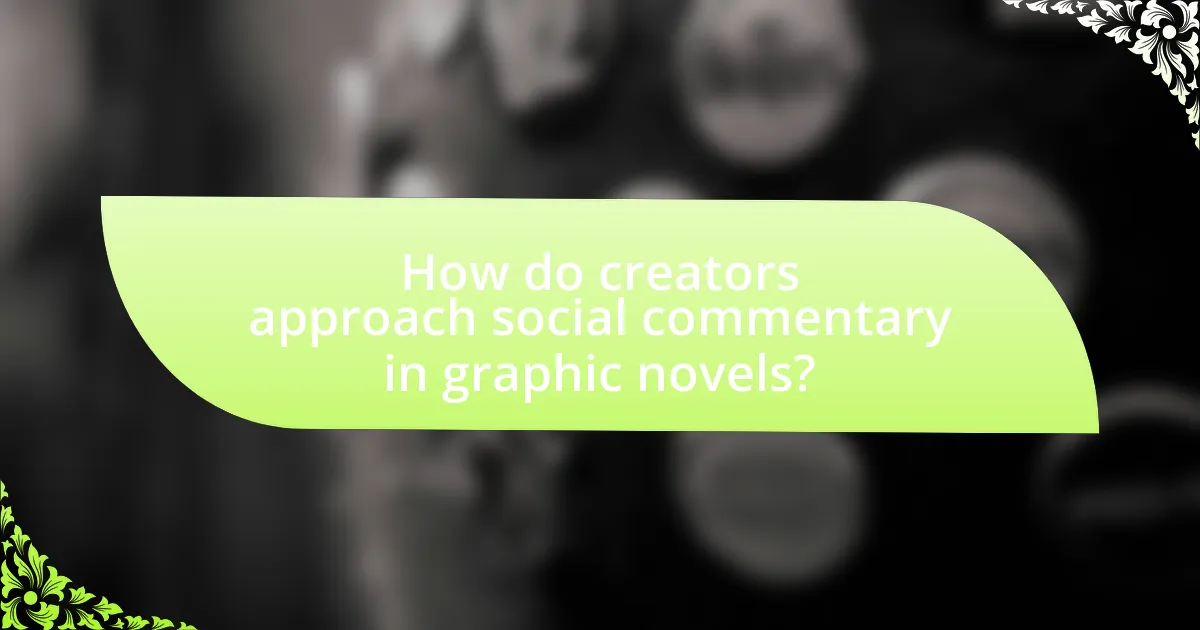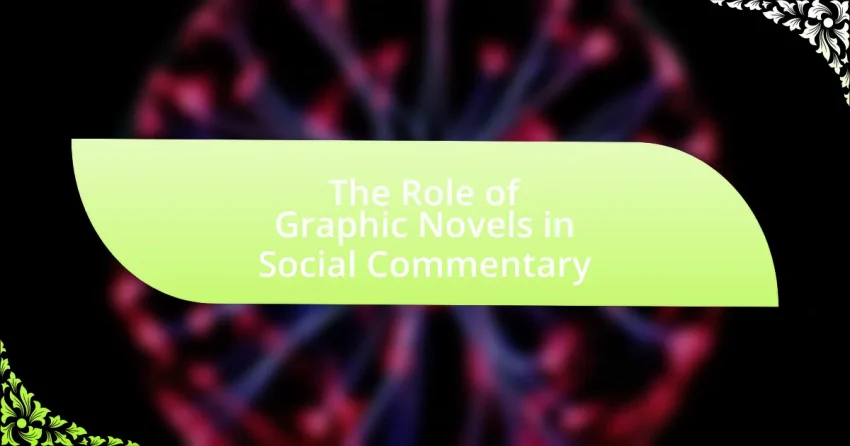Graphic novels play a significant role in social commentary by merging visual art and narrative to address complex societal issues such as identity, race, gender, and political themes. They engage diverse audiences through emotional and intellectual storytelling, making abstract concepts more accessible. Key elements like visual storytelling techniques, character development, and thematic depth enhance their impact, allowing for nuanced discussions on social challenges. Notable works, including “Maus” and “Persepolis,” illustrate how graphic novels can evoke empathy and provoke critical thought, while also highlighting the importance of authenticity and diverse representation in their creation.

What is the Role of Graphic Novels in Social Commentary?
Graphic novels serve as a powerful medium for social commentary by combining visual art and narrative to address complex societal issues. This format allows creators to engage readers emotionally and intellectually, making abstract concepts more accessible. For instance, works like “Maus” by Art Spiegelman and “Persepolis” by Marjane Satrapi tackle themes of war, identity, and oppression, illustrating the human experience behind historical events. The visual storytelling enhances the impact of the message, as images can evoke empathy and provoke thought in ways that text alone may not achieve. Furthermore, graphic novels often reach diverse audiences, including those who may not engage with traditional literature, thereby broadening the discourse on social issues.
How do graphic novels serve as a medium for social commentary?
Graphic novels serve as a medium for social commentary by combining visual art and narrative to address complex social issues. This unique format allows creators to depict themes such as inequality, identity, and injustice in a way that is accessible and engaging for a diverse audience. For instance, works like “Maus” by Art Spiegelman illustrate the Holocaust’s impact through personal stories, while “Persepolis” by Marjane Satrapi explores the Iranian Revolution from a personal perspective. These examples demonstrate how graphic novels can effectively convey nuanced messages and provoke critical thought about societal challenges.
What are the key elements that enable graphic novels to convey social messages?
Graphic novels convey social messages through a combination of visual storytelling, character development, and thematic depth. The integration of illustrations with text allows for a unique narrative style that can evoke emotional responses and enhance understanding of complex social issues. For instance, the use of symbolism in imagery can highlight societal injustices, while diverse character arcs can represent various perspectives on these issues. Additionally, the pacing and layout of graphic novels can emphasize critical moments, guiding readers’ focus and reinforcing the intended message. This multifaceted approach enables graphic novels to effectively engage readers and provoke thought on social topics.
How do visual storytelling techniques enhance social commentary in graphic novels?
Visual storytelling techniques enhance social commentary in graphic novels by using imagery, layout, and color to convey complex themes and emotions effectively. These techniques allow creators to illustrate societal issues, such as inequality or injustice, in a way that resonates with readers on a visceral level. For example, the use of contrasting colors can symbolize conflict, while varied panel sizes can manipulate pacing to emphasize critical moments. This visual language complements the narrative, making the social commentary more impactful and accessible. Studies have shown that readers often engage more deeply with visual narratives, as the combination of text and imagery can evoke stronger emotional responses, thereby reinforcing the intended message.
Why are graphic novels effective in addressing social issues?
Graphic novels are effective in addressing social issues because they combine visual storytelling with narrative depth, making complex topics more accessible and engaging. The integration of illustrations with text allows for emotional resonance, enabling readers to connect with characters and situations on a personal level. For instance, works like “Maus” by Art Spiegelman and “Persepolis” by Marjane Satrapi tackle themes of trauma and identity, illustrating the impact of historical events on individual lives. This duality of imagery and narrative not only captures attention but also fosters empathy, encouraging readers to reflect on societal challenges. Studies have shown that visual literacy can enhance understanding and retention of information, further solidifying graphic novels as powerful tools for social commentary.
What unique perspectives do graphic novels offer compared to traditional literature?
Graphic novels offer unique perspectives through their combination of visual art and narrative, allowing for a more immediate emotional impact and nuanced storytelling compared to traditional literature. This medium utilizes illustrations to convey complex themes and emotions, often making social commentary more accessible and engaging. For instance, works like “Maus” by Art Spiegelman and “Persepolis” by Marjane Satrapi effectively depict historical and cultural contexts through both text and imagery, enhancing the reader’s understanding of the subject matter. The interplay between visuals and words in graphic novels can also highlight contrasts and subtleties that may be less pronounced in prose, thus enriching the narrative experience and fostering deeper connections with social issues.
How do graphic novels engage diverse audiences in social discourse?
Graphic novels engage diverse audiences in social discourse by using visual storytelling to address complex social issues, making them accessible and relatable. The combination of images and text allows for nuanced narratives that resonate with various demographics, including marginalized groups. For instance, graphic novels like “Maus” by Art Spiegelman and “Persepolis” by Marjane Satrapi tackle themes of identity, trauma, and cultural history, prompting discussions on these topics across different communities. Research indicates that visual media can enhance understanding and empathy, as seen in studies showing that graphic narratives can effectively convey emotional experiences and foster dialogue among readers from different backgrounds.

What themes are commonly explored in graphic novels as social commentary?
Common themes explored in graphic novels as social commentary include identity, race, gender, and socio-political issues. Graphic novels often depict the complexities of personal and collective identity, as seen in works like “Persepolis” by Marjane Satrapi, which addresses cultural identity and the impact of war. Race is frequently examined, with titles such as “March” by John Lewis highlighting the civil rights movement and systemic racism. Gender issues are also prevalent, as illustrated in “Fun Home” by Alison Bechdel, which explores sexuality and family dynamics. Additionally, socio-political themes are prominent, with graphic novels like “V for Vendetta” by Alan Moore critiquing authoritarianism and surveillance. These themes serve to reflect and challenge societal norms, making graphic novels a powerful medium for social commentary.
How do graphic novels tackle issues of identity and representation?
Graphic novels tackle issues of identity and representation by using visual storytelling to explore diverse perspectives and experiences. They often feature characters from various backgrounds, including different races, genders, sexual orientations, and socio-economic statuses, which allows readers to engage with and understand complex identities. For instance, works like “Persepolis” by Marjane Satrapi illustrate the impact of cultural identity through the lens of a young Iranian girl during the Islamic Revolution, highlighting how personal and national identities intersect. Additionally, graphic novels such as “Fun Home” by Alison Bechdel address LGBTQ+ representation, providing insight into the author’s experiences with gender and sexuality. These narratives not only reflect the realities of marginalized groups but also challenge stereotypes, fostering empathy and awareness among readers.
What examples illustrate the exploration of race and ethnicity in graphic novels?
Graphic novels such as “American Born Chinese” by Gene Luen Yang and “Persepolis” by Marjane Satrapi illustrate the exploration of race and ethnicity. “American Born Chinese” addresses the complexities of Chinese-American identity through the experiences of its protagonist, highlighting issues of cultural assimilation and stereotypes. “Persepolis” offers a personal narrative of growing up in Iran during and after the Islamic Revolution, providing insights into the impact of political and cultural identity on ethnicity. Both works serve as critical commentaries on race and ethnicity, reflecting broader societal issues and personal struggles.
How do graphic novels address gender and sexuality issues?
Graphic novels address gender and sexuality issues by depicting diverse characters and narratives that challenge traditional norms. These works often explore themes of identity, representation, and the complexities of sexual orientation and gender roles. For instance, titles like “Fun Home” by Alison Bechdel and “Gender Queer” by Maia Kobabe provide personal insights into LGBTQ+ experiences, highlighting struggles and triumphs. Research indicates that graphic novels can foster empathy and understanding, as they visually represent marginalized voices, making complex issues more accessible to readers. This medium’s combination of visual art and storytelling effectively engages audiences in discussions about gender and sexuality, promoting social awareness and change.
What role do graphic novels play in political discourse?
Graphic novels serve as a powerful medium for political discourse by combining visual storytelling with complex narratives that engage readers on social and political issues. They often address themes such as injustice, inequality, and resistance, making them accessible to a broader audience. For instance, works like “Maus” by Art Spiegelman and “Persepolis” by Marjane Satrapi illustrate the impact of war and oppression, prompting discussions about historical and contemporary political contexts. These narratives can evoke emotional responses and foster empathy, which are crucial for understanding diverse perspectives in political debates. Additionally, graphic novels can challenge dominant narratives and provide a platform for marginalized voices, thereby enriching the political discourse landscape.
How have graphic novels influenced public opinion on political matters?
Graphic novels have significantly influenced public opinion on political matters by providing accessible narratives that engage readers emotionally and intellectually. For instance, works like “Maus” by Art Spiegelman and “Persepolis” by Marjane Satrapi have brought complex historical and political issues, such as the Holocaust and the Iranian Revolution, to a broader audience, fostering empathy and understanding. Research indicates that graphic novels can effectively communicate political themes, as they combine visual storytelling with textual elements, making them more relatable and impactful than traditional prose. This medium has been utilized in various movements, such as the civil rights movement, where graphic novels like “March” by John Lewis have played a crucial role in educating the public and mobilizing support for social justice causes.
What are notable graphic novels that have sparked political movements?
Notable graphic novels that have sparked political movements include “Maus” by Art Spiegelman, which addresses the Holocaust and has been used in discussions about anti-Semitism and genocide. “Persepolis” by Marjane Satrapi highlights the Iranian Revolution and has inspired activism regarding women’s rights and freedom of expression in Iran. “V for Vendetta” by Alan Moore and David Lloyd critiques totalitarianism and has been associated with various protests against government oppression. Each of these works has not only influenced public discourse but also mobilized readers to engage in political activism, demonstrating the power of graphic novels as tools for social commentary and change.

How do creators approach social commentary in graphic novels?
Creators approach social commentary in graphic novels by integrating narrative and visual elements to reflect societal issues and provoke thought. They often use character development, plotlines, and artistic styles to address themes such as inequality, identity, and political unrest. For instance, works like “Maus” by Art Spiegelman and “Persepolis” by Marjane Satrapi exemplify how personal stories can illuminate broader historical and cultural contexts, effectively engaging readers with complex social realities. This method allows creators to convey nuanced perspectives, making the commentary accessible and impactful.
What techniques do authors and illustrators use to convey their messages?
Authors and illustrators use a variety of techniques to convey their messages, including visual storytelling, symbolism, and dialogue. Visual storytelling allows creators to depict complex narratives through images, enhancing emotional impact and engagement. Symbolism is employed to represent deeper meanings, where specific images or colors evoke particular themes or ideas, such as using dark colors to signify despair. Dialogue, often presented in speech bubbles, provides direct insight into characters’ thoughts and motivations, facilitating a connection between the audience and the narrative. These techniques are essential in graphic novels, as they effectively communicate social commentary and provoke critical thought among readers.
How does collaboration between writers and artists enhance social commentary?
Collaboration between writers and artists enhances social commentary by combining narrative depth with visual storytelling, creating a more impactful message. This synergy allows complex themes to be conveyed through both text and imagery, making social issues more accessible and engaging to a wider audience. For instance, graphic novels like “Maus” by Art Spiegelman effectively use illustrations to depict the Holocaust, deepening the emotional resonance of the narrative. Studies show that visual elements can significantly influence readers’ understanding and retention of social issues, as seen in research published in the Journal of Visual Literacy, which highlights how images can evoke empathy and provoke critical thought. Thus, the partnership between writers and artists in graphic novels amplifies the effectiveness of social commentary.
What role does research play in the creation of socially conscious graphic novels?
Research plays a crucial role in the creation of socially conscious graphic novels by providing accurate information and context that informs the narrative and themes. This foundational research allows creators to explore complex social issues, such as systemic inequality or cultural identity, with depth and authenticity. For instance, graphic novels like “Persepolis” by Marjane Satrapi draw on historical and cultural research to depict the Iranian Revolution, ensuring that the portrayal is both truthful and impactful. Additionally, studies have shown that well-researched narratives can enhance reader engagement and empathy, making the social commentary more effective.
What challenges do graphic novelists face when addressing social issues?
Graphic novelists face significant challenges when addressing social issues, primarily due to the need to balance artistic expression with the sensitivity of the topics. This balance is crucial as graphic novels often tackle complex themes such as race, gender, and mental health, which can provoke strong emotional responses from readers. Additionally, graphic novelists must navigate the risk of oversimplifying nuanced issues, which can lead to misrepresentation or reinforce stereotypes. For instance, the graphic novel “Persepolis” by Marjane Satrapi effectively addresses the Iranian Revolution but also faced criticism for its portrayal of cultural complexities. Furthermore, graphic novelists often encounter market constraints, as publishers may be hesitant to support works that challenge societal norms or address controversial subjects, limiting the reach and impact of their narratives.
How do censorship and market pressures affect the content of graphic novels?
Censorship and market pressures significantly shape the content of graphic novels by limiting themes, altering narratives, and influencing artistic expression. Censorship can arise from governmental regulations, cultural norms, or publisher restrictions, leading to the exclusion of controversial topics such as politics, sexuality, or violence. For example, the graphic novel “Persepolis” by Marjane Satrapi faced censorship in various countries due to its political content and critique of the Iranian regime. Market pressures, driven by consumer demand and sales potential, compel creators to conform to popular trends or avoid risky subjects that might alienate audiences. This is evident in the rise of superhero narratives, which dominate the market, often sidelining more diverse or experimental storytelling. Together, these factors create an environment where graphic novels may prioritize commercial viability over artistic integrity, ultimately affecting the diversity and depth of social commentary within the medium.
What are the risks of misrepresentation in social commentary through graphic novels?
Misrepresentation in social commentary through graphic novels can lead to the perpetuation of stereotypes and misinformation. Graphic novels often simplify complex social issues, which can result in a skewed portrayal of marginalized communities. For instance, when graphic novels depict racial or cultural groups through a narrow lens, they can reinforce harmful stereotypes, as seen in works that fail to accurately represent the diversity within those communities. This misrepresentation can influence public perception and contribute to societal biases, as readers may internalize these flawed narratives. Furthermore, the lack of diverse voices in the creation of graphic novels can exacerbate these risks, leading to a homogenized view that does not reflect the realities of the subjects being portrayed.
What are some best practices for creating impactful graphic novels focused on social commentary?
To create impactful graphic novels focused on social commentary, authors should prioritize authenticity, character development, and visual storytelling. Authenticity ensures that the themes resonate with real-world issues, allowing readers to connect deeply with the narrative. Character development is crucial, as well-rounded characters can embody the social issues being addressed, making the commentary more relatable and engaging. Visual storytelling enhances the message; effective use of imagery can evoke emotions and highlight key themes, reinforcing the narrative’s impact. For instance, Art Spiegelman’s “Maus” effectively uses the graphic novel format to address the Holocaust, combining personal narrative with historical context, which illustrates how visual elements can amplify social commentary.
How can aspiring graphic novelists effectively research social issues?
Aspiring graphic novelists can effectively research social issues by utilizing a combination of academic resources, interviews, and community engagement. Academic resources, such as scholarly articles and books, provide in-depth analysis and historical context on various social issues, allowing writers to understand the complexities involved. For instance, the Pew Research Center offers extensive studies on social trends and public opinion, which can inform narrative development.
Interviews with experts, activists, or individuals directly affected by the issues can provide personal insights and real-life experiences, enriching the narrative authenticity. Engaging with communities through forums, social media, or local events can also help graphic novelists gather diverse perspectives and understand the nuances of the issues they wish to portray.
By combining these methods, aspiring graphic novelists can create informed and impactful stories that resonate with readers and contribute to social discourse.
What strategies can be employed to ensure diverse representation in graphic novels?
To ensure diverse representation in graphic novels, creators should actively include voices from various cultural, racial, and gender backgrounds in both storytelling and artistic roles. This can be achieved by collaborating with writers and artists from underrepresented communities, which enriches narratives and perspectives. For instance, graphic novels like “Ms. Marvel” by G. Willow Wilson and Adrian Alphona showcase a Pakistani-American superhero, reflecting the importance of cultural authenticity. Additionally, publishers can implement diversity initiatives, such as mentorship programs for aspiring creators from marginalized groups, to foster a more inclusive industry. Research indicates that diverse representation not only resonates with a broader audience but also enhances the overall quality of storytelling, as seen in the success of titles that prioritize inclusivity.
